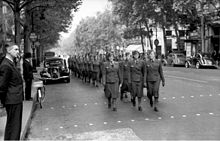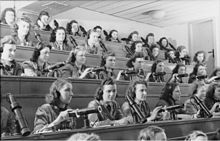Armed Forces Assistant
Wehrmachthelferin (also with Fugen-s ) was the name for girls and young women who did service in the German Wehrmacht during the Second World War .
commitment
More than half a million women were military assistants for a shorter or longer period of time. More than half of them volunteered, the others were required to do emergency service or military service. Like the willing prisoners of war (see “ Hilfswilliger ”), they were part of the so-called makeshift staff.
The women were not only deployed in the German Reich , but to a small extent also in occupied areas, for example in the Generalgouvernement , France , in the Reichskommissariat Ostland , and later also in Yugoslavia, Greece, Italy and the allied Romania , as staff assistants. They performed military auxiliary services, were subordinate to military superiors and worked under the provisions of military law .

They worked mostly
- as telephone operators, telex operators, radio operators, shorthand typists , office assistants and messengers,
- in the Reich Air Defense in listening service, air watch service, flight reporting service, weather service , hunter control service and air protection service
- in air defense on anti-aircraft guns (flak) z. B. on headlights or as auxiliary gunners on anti-aircraft equipment (see below) and
- in the military medical service (so-called voluntary nursing of the German Red Cross and other charitable organizations. See also: “ Nursing under National Socialism ”).
The military assistants often took over the jobs of soldiers who were posted to the front. Some military units were made up almost entirely of women at the end of the war. Their training lasted a maximum of 12 weeks.
De facto women soldiers
In the last years of the war, female helpers were also used as soldiers, although never referred to as such. In August 1944, for example, 660,000 regular male soldiers and 450,000 women ("anti-aircraft personnel") served in the air defense force. The flak headlight batteries were mostly operated by women.
In 1945 anti-aircraft helpers were allowed handguns for self-defense. In February 1945, the helpers of the three Wehrmacht parts ( army , air force , navy ) were combined in the Wehrmacht Helper Corps .
The army helper corps reached its greatest size at the turn of the year 1944/45. During this time, many helpers, just like the soldiers and the civilian population, suffered from low-level aircraft attacks, bombings, hasty refugee movements, hunger and a collapsing infrastructure.
It is unknown how many military assistants died in the exercise of their service, became disabled or were taken prisoners of war .
Reception after the war
In 1978, Franz W. Seidler , at the time professor of social and military history at the University of the Bundeswehr in Munich , published the book "Women at Arms?" And subsequently further studies under the title of the contemporary name "Blitzmädchen". Seidler also investigated how far the helpers became combatants by performing combat support functions .
Lightning girl
"Blitzmädel" or "Blitzmaiden" was a nickname from the language of the soldiers , sometimes with a derogatory connotation. The designation was derived from the lightning bolt emblem, the badge on the uniform sleeve or on the tie, the lightning bolt in turn was an emblem of the Wehrmacht and Waffen SS intelligence units .
Film adaptations
- 1958 Blitzmädels to the front , directed by Werner Klingler , script: Hans Hellmut Kirst , with Eva-Ingeborg Scholz (Oberführer Hanna Helmke), Horst Frank (Gaston), Klausjürgen Wussow (Oberleutnant Wagner) and Werner Peters (medical officer in the military district command) .
See also
- Stage helper
- National Socialist image of women
- Reich Labor Service
- SS helpers
- Women in the military
- HJ naval helper
- Flak helpers
- Air Force Aid
literature
- Jan Willem van Borselen: Blitzmädel. A life story between seduction and awakening. SV Thorsten Neubert-Preine and Lars Przybylski, Bomlitz 2012, ISBN 978-3-00-040436-8 .
- Hildegard Gartmann: lightning girl. Documentary novel. Limes, Wiesbaden 1971 DNB 456702539 .
- Ursula von Gersdorff : Women in War Service 1914–1945 (= contributions to military and war history . Volume 11). DVA, Deutsche Verlagsanstalt, Stuttgart 1969, DNB 456654356 .
- Kathrin Kompisch: perpetrators. Women under National Socialism. Böhlau, Cologne / Weimar / Vienna 2008, ISBN 3-412-20188-X .
- Marita Krauss (Ed.): You were there. Followers, beneficiaries, perpetrators under National Socialism . Wallstein, Göttingen 2008, ISBN 978-3-8353-0314-0 .
- Birthe Kundrus : Only half the story. Women around the Wehrmacht between 1939 and 1945. In: Rolf-Dieter Müller, Hans-Erich Volkmann (Hrsg.): The Wehrmacht. Myth and Reality. Oldenbourg, Munich 1999, pp. 719-735. ISBN 3-486-56383-1 .
- Franka Maubach: Holding the position: War experiences and life stories of military helpers , Vandenhoeck & Ruprecht, Göttingen 2009, ISBN 978-3-525-36167-2 (dissertation University of Jena 2009, 349 pages).
- Alison Morton: Military or civilians? The curious anomaly of the German Women's Auxiliary Services during the Second World War. Kindle Edition 2012.
- Franz W. Seidler : lightning girl. Wehrmacht helpers. Bechtermünz, Augsburg 2003, ISBN 3-8289-0531-5 .
- Sybille Steinbacher (Ed.): Volksgenossinnen: Women in the NS-Volksgemeinschaft (= contributions to the history of National Socialism , Volume 23). Wallstein, Göttingen 2012, ISBN 978-3-8353-2207-3 .
- Gerda Szepansky : "Blitzmädel", "Hero Mother", "War Widow". Women's life in World War II. Fischer-Taschenbuch 3700, Frankfurt am Main 1986–1995, ISBN 3-596-23700-9 .
- Gordon Williamson: World War II German Women's Auxiliary Services (Men-at-Arms). Osprey, Oxford 2003. ISBN 1-84176-407-8 .
- Regulation M.Dv.Nr. 465, H.Dv. 28, L.Dv. 28 - The flight reporting service. 1939.
Web links
- A contemporary witness report (PDF; 83 kB)
- "The lightning girls" or the feminine side of war. Contemporary witnesses report: Wehrmacht helpers in the Second World War ( Memento from November 25, 2011 in the Internet Archive )
Individual evidence
- ↑ Deutsche Rentenversicherung: Explanations on the questionnaire for replacement periods, V0401 ( Memento from July 24, 2016 in the Internet Archive ) (PDF), accessed on July 24, 2016.
- ↑ Kathrin Kompisch: Perpetrators. Women in National Socialism , Böhlau, Cologne 2008, p. 219, ISBN 978-3-412-20188-3 ( publisher information ).
- ^ Report in: Kreiszeitung.de
- ↑ Short review in: DER SPIEGEL 14/1971


